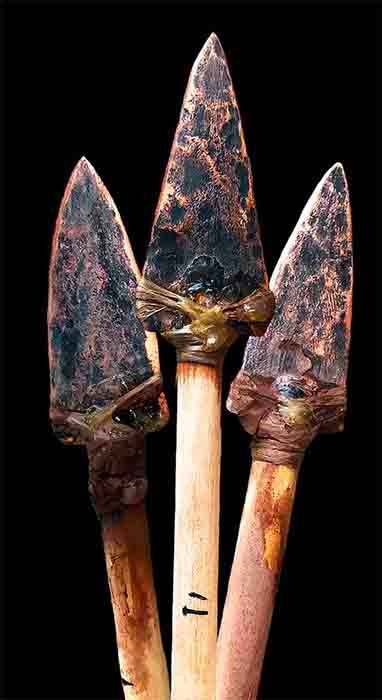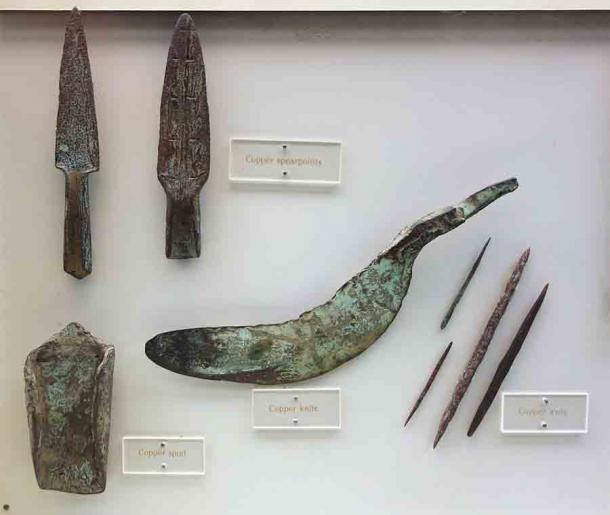Refinements in radiocarbon dating technology have caused archaeologists, anthropologists, and ancient historians to modify their beliefs about the timeline of copper tools and the metalworking of the Old Copper Culture, which emerged among Native Americans living in the Great Lakes region of North America many thousands of years ago. Past estimates traced the start of the Old Copper Culture to approximately 4,000 BC. Mysteriously, the Old Copper Culture ended around 1,000 BC, when the Great Lakes hunting and gathering populations largely abandoned copper tools and returned to using tools and other implements made from stone and bone.
But new findings have expanded this timeline. Re-dating of old discoveries and more refined dating of new ones have pushed the starting date of the Old Copper Culture back much farther, to the year 7,500 BC. The use of copper tools among Native Americans who built this culture peaked between 5,000 BC and 3,000 BC, before declining precipitously after that.
New Radiocarbon Dating Changes Copper Tools’ Timeline
Some of the world’s largest copper deposits are found beneath the ground in the area around the Great Lakes , and these deposits are highly pure and malleable. Old Copper Culture coppersmiths created a range of useful copper tools and implements, including projectile points that could be used for hunting, strong and heavy axes and knives, small and intricately crafted fish hooks , and sharp pointed awls that could be used for punching holes in animal skins, etc.
Many copper and non-copper artifacts from this era have been found, by amateurs and professionals alike, which fortunately gives scientists plenty of material to work with as they attempt to learn more about the people who made them.

Copper-tipped projectiles made by the Old Copper Culture of the Great Lakes region, North America. ( Michelle Bebber / Kent State University Eren Laboratory )
A team of researchers, led by Kansas State University geologist David Pompeani, performed a fresh round of radiocarbon dating on 53 separate copper tool discoveries associated with the Old Copper Culture in the Great Lakes region. Using the most modern and reliable dating technology available, they proved that the oldest artifact in their possession was an 8,500-year-old 10-centimeter (4-inch), sharped-pointed projectile that was left by hunter-gatherers near Eagle Lake in Wisconsin.
From an historical perspective, this is contemporaneous with an 8,700-year-old copper pendant found in the Middle East, which can be traced to the copper-working cultures that arose in that part of the world.
In addition to looking at copper tools, the scientists also performed dating tests on wood and cordage that was attached to copper spear points, and on charcoal, wood, and bone found in Old Copper Culture mines and burial plots. Sediment samples taken from several lakes adjacent to ancient copper mines in Michigan were also used to identify trace metals that would have been left behind by mining activity, adding another layer of confirmation to the revised radiocarbon dating profile.
From this accumulated data, they were able to prove that the Old Copper Culture first emerged approximately 9,500 years ago. This makes it one of the oldest metal-working cultures ever discovered, anywhere on Earth.

Archaic Indian copper tools and artifacts, 3000 BC-1000 BC, exhibited in the Wisconsin Historical Museum, Madison, Wisconsin, USA. (Daderot / CC0)
Why Did The Old Copper Culture And Copper Tools Decline?
There is one thing about the North American Old Copper Culture that makes it unique. After copper tool-making activity among Great Lakes Native Americans peaked around 3,000 BC, the practice went into decline after that. The archaeological record shows that the region’s inhabitants had returned to using tools made from stone and bone almost exclusively by 1,000 BC.
Why would such a change have occurred? David Pompeani and anthropologist Michelle Bebber from Ohio’s Kent State University Eren Laboratory (experimental archaeology) have each published research that may shed light on this unprecedented and unusual “reverse” development.
Professor Pompeani has collected data from sediment cores and tree rings that suggest the Great Lakes region experienced drought-like conditions for an extended period of time starting around 5,000 BC. This would have placed great strain on Native Americans who lived there and relied on the land to provide them with all the essentials of life.
Under these circumstances, the associated social and ecological displacement may have caused a shift in survival-related practices . Societies struggling to survive may have been limited to the basics, giving them less time to devote to mining copper and processing it to make durable copper tools. Beyond a certain point, practical considerations may have motivated a return to bone and stone, with copper reserved primarily for luxury items like the beads, bracelets, and other decorative items that have been found at various Great Lakes archaeological sites.

An ancient 12.1-ounce (340-gram) nugget of natural native copper from the glacial drifts of Michigan. (Rob Lavinsky, iRocks.com – CC-BY-SA-3.0 / CC BY-SA 3.0 )
In her research project , Bebber and associates replicated Old-Copper-style arrowheads, knives, and awls, using both copper and stone and bone to make these carefully crafted tools and implements. Laboratory tests found that the stone and bone knives and arrowheads were nearly as efficient and effective as similar items made from Great Lakes area copper, which because of its purity is somewhat softer than copper alloys mined in other parts of the world.
Significantly, only the copper awls, which require small amounts of material to make, clearly outperformed the bone and stone alternatives. As Bebber confirms, this was the one type of copper tool that Native Americans in the Great Lakes region continued to use, even after the Old Copper Culture had largely faded from existence.
If Pompeani is right, and environmental stressors reduced the time and resources Native Americans in the region could devote to mining and metal working, the relatively small advantages that copper might have offered (according to Bebber’s research) would not have been enough to keep them involved in the industry.
Peripheral activities involving salvaged copper might have continued, but copper mining would have eventually ceased to exist, even as it continued in other parts of the world.
Top image: Copper tools from the Old Copper Culture of the Great Lakes region. Source: Michelle Bebber / Kent State University Eren Laboratory
By Nathan Falde
 RSS Feed
RSS Feed















 March 23rd, 2021
March 23rd, 2021  Awake Goy
Awake Goy  Posted in
Posted in  Tags:
Tags: 













